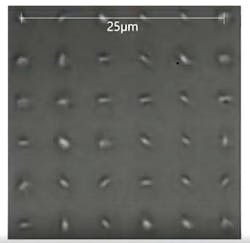Microsoft's Project Silica exploring voxel-based optical data storage
Project Silica is a Microsoft (Redmond, WA) research initiative to store data in quartz glass cubes using laser light. Microsoft is collaborating with the UK's University of Southampton Optoelectronics Research Centre (ORC; Southampton, England). Squares of quartz glass store voxels (volume elements)—the 3D equivalent of pixels—in a volumetric area within the glass. A 6 x 6 array of voxels occupies a 25 micron square area, and there is a 5 micron separation between these voxels.
RELATED ARTICLE: Ultrafast lasers enable rapid, photo-magnetic optical storage
There can be layers of voxels, with Microsoft Azure CTO Mark Russinovich mentioning five. The voxels are "burned" into the glass using a femtosecond laser, meaning a flash of light whose duration is measured in quadrillionths of a second. A voxel's bit value is differentiated from other voxels in terms of the laser light's retardance and level of polarization. This kind of laser is used to avoid breaking the glass, according to the CTO.
In effect, a pattern is ingrained into a voxel area in the glass and represents a set of bit values. Microsoft gold partner NeroBlanco estimated that "A piece of glass about 1 inch square can hold 50TB of data."
The article continues by revealing that Project Silica is a WORM (Write Once Read Many) medium and several years away from being a deployable product, as there may be difficulties to get over in positioning a laser read beam above the voxels to read them precisely.
There is no information available about likely read and write time, or how the voxel slab is brought to the reader. The appeal of Project Silica is that the glass could last, Russinovich says, "forever". This could be the ultimate long-term storage. It reminds us of Millenniata's 1,000 year M-Disc, which was introduced in 2009. There are 4.7GB, 25GB, 50GB and 100GB versions of this Blu-ray disc.
Project Silica has, for now, no impact on the storage industry or users. Many suppliers and researchers have tried to produce long-lasting, high-capacity optical media, particularly in the holographic disk area. All failed. In the greater-than-500-years-life media area, only niche suppliers like Milleniata survive.
Microsoft is betting that public cloud storage needs for unstructured data will rocket skywards into the exabyte area in coming years, and thinks Project Silica could meet that storage need then.
SOURCE: The Register; https://www.theregister.co.uk/2018/04/11/pelican_maids_in_the_azure_and_femtosecond_laser_glass_storage/

Gail Overton | Senior Editor (2004-2020)
Gail has more than 30 years of engineering, marketing, product management, and editorial experience in the photonics and optical communications industry. Before joining the staff at Laser Focus World in 2004, she held many product management and product marketing roles in the fiber-optics industry, most notably at Hughes (El Segundo, CA), GTE Labs (Waltham, MA), Corning (Corning, NY), Photon Kinetics (Beaverton, OR), and Newport Corporation (Irvine, CA). During her marketing career, Gail published articles in WDM Solutions and Sensors magazine and traveled internationally to conduct product and sales training. Gail received her BS degree in physics, with an emphasis in optics, from San Diego State University in San Diego, CA in May 1986.
